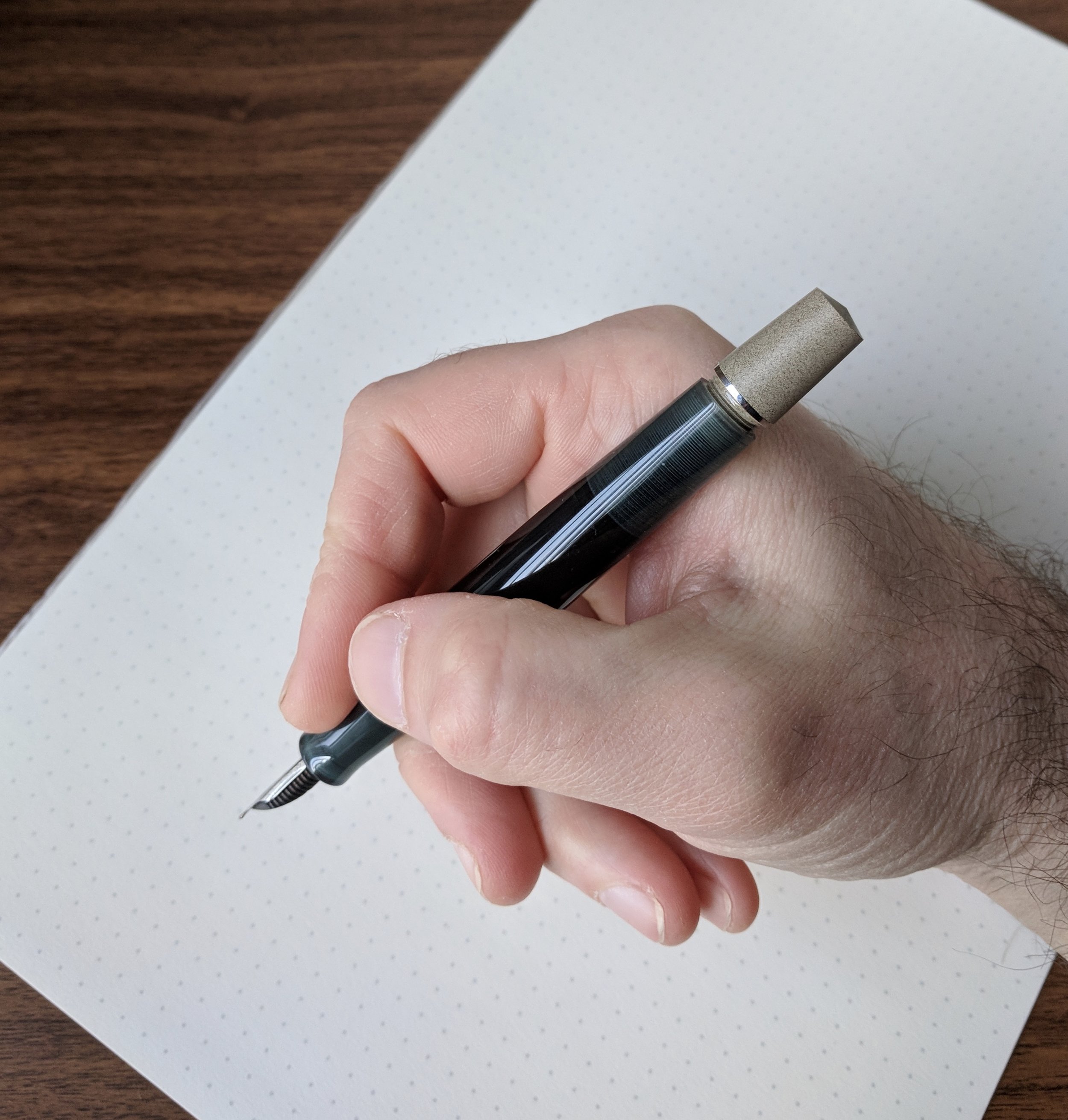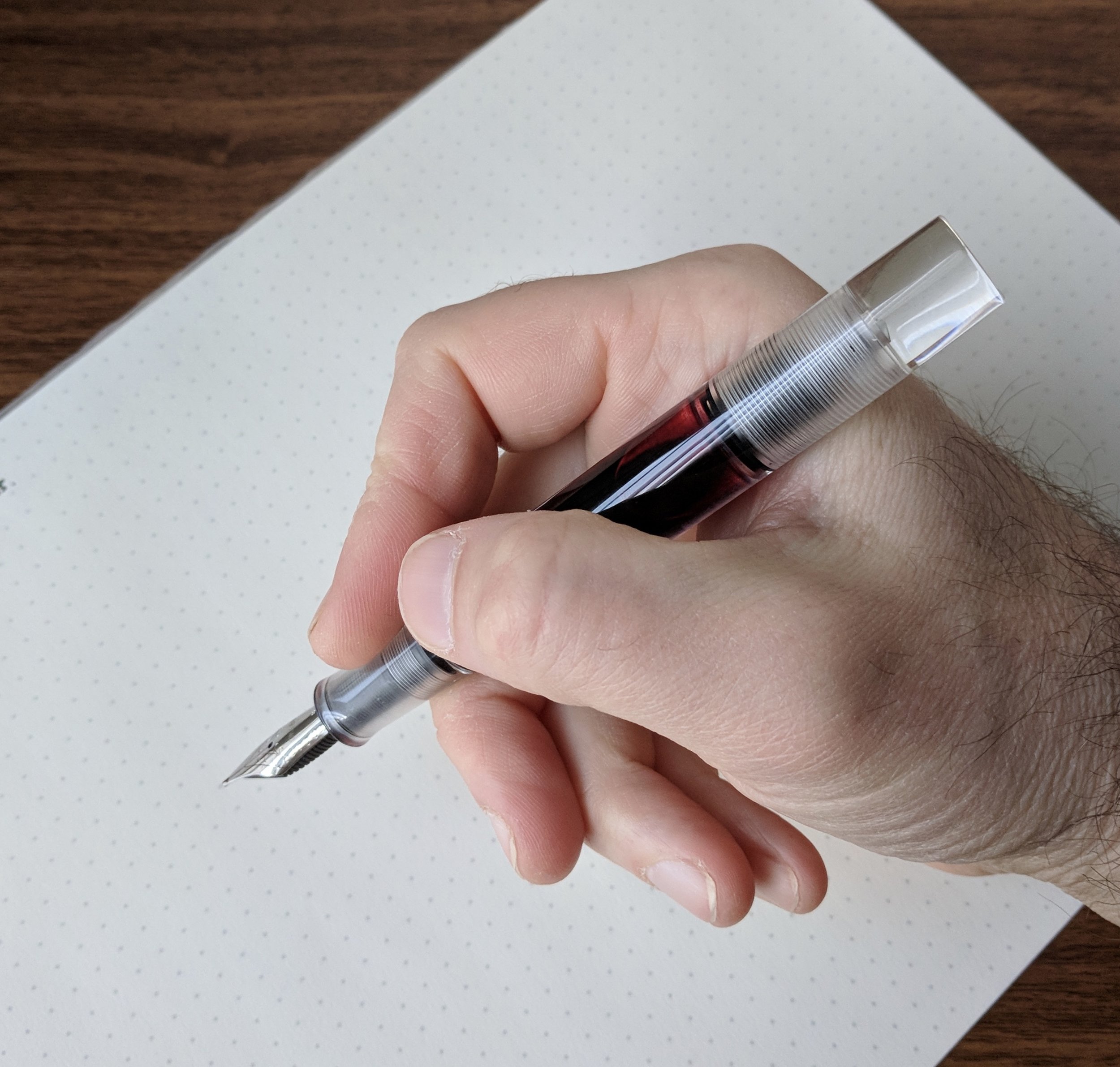As part of this general trend of downsizing everything to a more manageable size, I’ve been trying to write dry all of the various fountain pens that I have inked up, and wow, is that hard to do when so many of them are cartridge-converter pens set up as eyedroppers. I go back and forth on whether, overall, I enjoy eyedroppering. While it’s nice to have the ginormous ink capacity, I’m not sure that convenience outweighs the various downsides given where I live and my current work/life situation.
A Bit of Background
For those new to pens, an “eyedropper” or “eyedroppering” is when you manually fill the barrel of a fountain pen with, well, an eyedropper directly from a bottle of ink. In today’s fountain pen market, there are two types of eyedroppers: Japanese-style eyedropper pens, which comes equipped with a valve system you can use to prevent leaks when you’re not writing, and the “converted” eyedropper, which is essentially a cartridge-converter pen sealed in a manner that allows you to use the full barrel as an ink reservoir. Eyedropper fountain pens can be great for those of us who do a lot of writing, as they can easily hold 3-5ml of ink in the barrel, depending on the size of the pen.
The Schon DSGN Ultem Fountain Pen in Amber (right) is eyedroppered.
To Eyedropper, or Not to Eyedropper
At this point in my fountain pen “career,” I’m not as much of a serial ink changer and mostly enjoy using the same handful of colors, so I can appreciate not having to refill fountain pens very often. That said, the recent hot weather here in balmy Tennessee reminds me of the many downsides to eyedropper fountain pens, namely drastic temperature swings moving outdoors to the car to the office, which causes the pen to burp - no, belch, ink into the cap unless there’s a valve mechanism like that available in the Opus 88 series. For this reason, I’m personally moving away from eyedroppers in favor of other filling options, unless the pen in question has a shut-off valve.
The sections of the Schon DSGN Engineered Plastics Fountain Pens come with o-rings installed. No silicone grease is necessary, though some people choose to use it for double protection against leaks.
For those who live in more moderate climates, or who view maximizing ink capacity and eyedroppering as a challenge they absolutely cannot pass up, there are a few things you can do to ensure that your eyedropper fountain pens behave and don’t cover you in ink.
Add O-Rings or Silicon Grease. If you don’t seal the threads around the section and the screw in nib unit, ink will eventually migrate up the threads and leak. Silicon grease is inexpensive and can be purchased from many pen shops. You only need to use a small amount (just enough to coat and fill the area between the threads), and for the section, a thin rubber o-ring will work as well. (Schon DSGN plastic pens, discussed below, already come equipped with o-rings and “eyedropper ready”.)
Fill ‘er Up! If you’re going to be flying with the pen, or otherwise moving between locations with large temperature or air pressure swings, make sure the pen is full before travel. It’s counterintuitive, but a full pen without any air in the barrel is much less likely to leak. The number one cause of fountain pen “inkcidents” is air expansion due to shifts in temperature and pressure, which causes air in the barrel to expand, pushing ink out the nib. For more on traveling/flying with fountain pens, check out this post here.
Keep the Pens Nibs Up. The main reason I prefer the Opus 88-style eyedropper pens is because you don’t have to worry about this factor. I’m back to commuting 3-4 days a week, so my pens are going with me in the car each day. In addition to the wild temperature swings we’ve been experiencing, I’ve had issues with ink leaking out if my briefcase falls over or my pen case shifts sideways, not to mention if I’m flying and have to slide my carry-on bag under the seat or into the overhead compartment.
Franklin-Christoph Model 20 (left) and Model 03 (right, orange pen) generally make good eyedroppers if you remove the converter and apply grease.
What Are the Best Fountain Pens for Eyedroppering?
Generally speaking, any plastic or acrylic pens without holes in the barrel or internal metal parts can be eyedroppered. (Metal doesn’t play well with liquid, though some people have had success with non-reactive titanium. Personally, I don’t tempt fate.) That said, there are a few brands that market their pens as “eyedropper friendly,” with caveats. Note that these will all require some work on your part to convert from cartridge-converter to eyedropper, as I’ve noted above, with the exception of the Opus 88 eyedroppers.
Most Franklin-Christoph Fountain Pens. I’m partial to the Model 20, which has a slip cap and a No. 6 JoWo Nib. Their smaller pens that feature the No. 5 JoWo nib also have better inkflow when eyedroppered, in my opinion. (This is due to the nib and feed, not the pen design.)
Schon DSGN Engineered Plastics Collection. You can read my full write-up here, but as I mentioned above, these pens come equipped with multiple o-rings to make them as eyedropper-friendly as possible.
Most Acrylic or Ebonite Bespoke or Custom Pens. Buy a pen from Shawn Newton or Edison Pens, and you can probably eyedropper it, provided you add silicone grease or an o-ring. If you’re ordering a custom pen specifically to be used as an eyedropper, let them know and they may be able to design the pen to maximize the ink capacity.
I hope you found this post helpful! Going forward, I’d like to write more of this type of “Fountain Pens 101” content. If there are topics that you’d like to hear or learn more about, leave a comment or drop me a line via the “Contact Me!” page. I’d love to hear from you!
NOTE: We are clearing out a lot of our store in anticipation of a site redesign/redirection. Take 10% off all orders using the coupon code SUMMER at checkout, in addition to already low clearance pricing on certain items. Excludes certain brands, including TWSBI and Lochby.
This post does not contain affiliate links or paid advertising. Any third-party links are uncompensated referrals.



